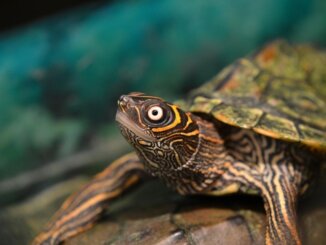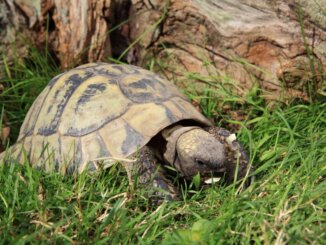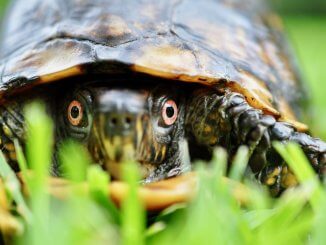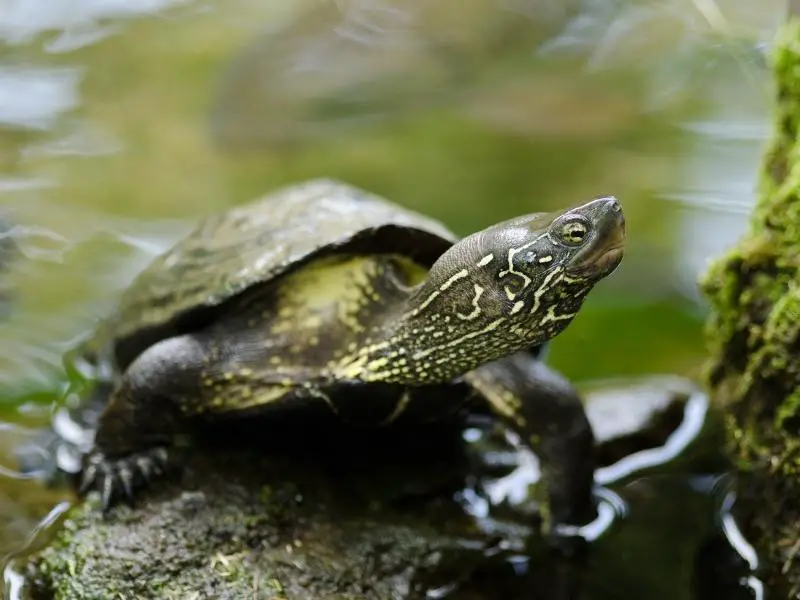
The Reeves turtle is a small, dark brown or olive green turtle that originated in China. Reeves turtles have since spread throughout Asia, including Vietnam, Taiwan, Japan, and Korea.
Reeves turtles are easygoing, hardy, and easy to care for, so they’re suitable pets for beginner reptile keepers.
Reeves Turtle Overview
| Common name | Reeves turtle, Chinese three-keeled pond turtle, Chinese pond turtle |
| Scientific name | Mauremys reevesii |
| Natural habitat | Slow-moving waters, like ponds, streams, and rivers. |
| Adult size | 6–9 inches |
| Average lifespan | 10–15 years |
| Diet | Omnivore |
| Housing | Minimum 30 gallons, 70–80°F, 70%–90% humidity |
| Experience | Beginner |
Origin
The Reeves turtle (Mauremys reevesii) originates in China and is now widespread across Asia. The turtle’s natural habitat is warm, slow-moving waters, such as ponds, lakes, and rivers. Reeves turtles enjoy swimming and basking on the lake shore.
Reeves turtles are considered a threatened species due to poaching and habitat destruction.
Appearance and Behavior
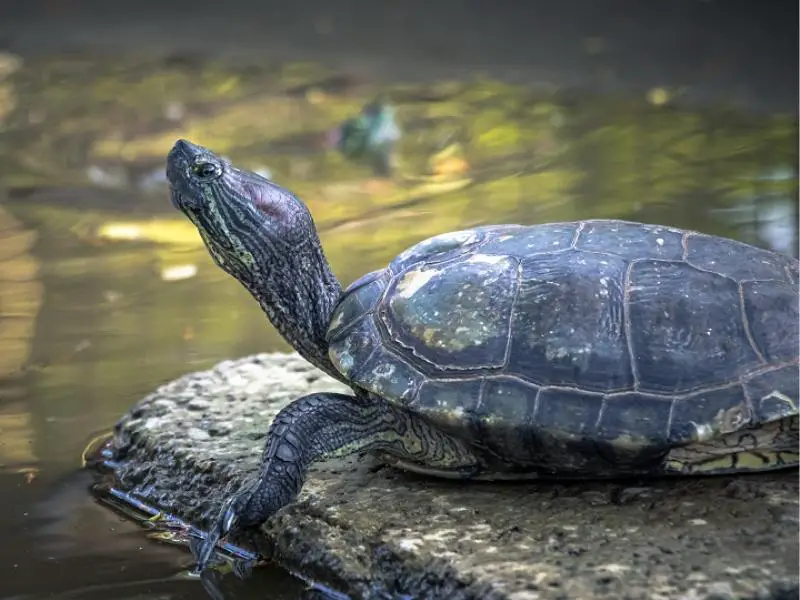
The Reeves turtle has a slightly rectangular shell in olive green or brown, with cream-colored plastrons that are marked with gray or dark brown. Reeves turtles have pale mottled patterns on their heads.
Female Reeves turtles and young turtles typically have yellow stripes on their necks. Females have shorter tails than males, and males’ tails have a bulge at the base.
Size and Lifespan
The Reeves turtle is 6–9 inches long. In captivity, most Reeves turtles stop growing at 6 inches.
The average lifespan of the Reeves turtle is 10–15 years. With a proper diet and good care, these turtles are known to live up to 20 years in captivity.
Temperament
Reeves turtles are a peaceful, shy, active species. These turtles spend most of their time basking on a rock or exploring the water.
Several Reeves turtles can be housed together as long as they have enough room to claim their own territories, which reduces the risk of stress and fighting. Reeves turtles don’t enjoy being handled and may bite, scratch, or attempt to escape if they’re held for any longer than one minute at a time.
Housing Reeves Turtles
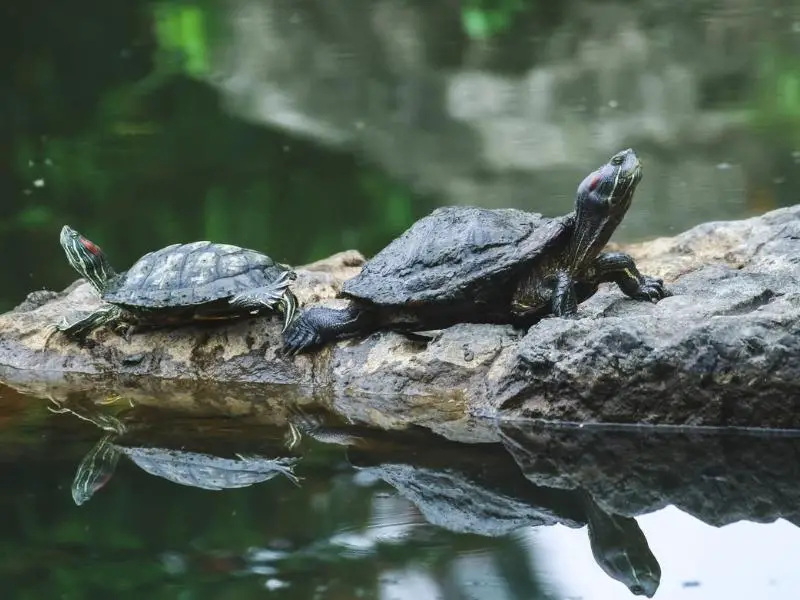
The Reeves turtle’s natural habitat is lakes, ponds, and streams in Asia. Replicate this habitat in captivity to ensure your turtle is healthy and comfortable.
Reeves turtles should be housed in a glass turtle aquarium that allows for water and land space.
Enclosure size
The minimum enclosure size for a Reeves turtle is 30 gallons. Ideally, a single turtle should be housed in a 50 gallon tank. The turtle is an active species that enjoys exploring on land and underwater. To provide enough swimming space for the Reeves turtle, the tank should be at least 11 inches tall. Two Reeves turtles should be housed in a 50–75 gallon tank.
Lighting
A basking lamp, a UV lamp, and natural lighting are all needed in a Reeves turtle enclosure.
Natural lighting from a window, or artificial lighting that mimics natural lighting in a dark room, is essential to establish a day-to-night cycle in captivity. UVB light enables Reeves turtles to synthesize vitamin D. Without vitamin D (especially D3), Reeves turtles can’t metabolize calcium properly, affecting their growth.
Place the UVB bulb in or near the basking area, ensuring that it is between 12 and 18 inches above the floor of the enclosure.
Temperature and Humidity
Reeves turtles are cold-blooded animals, which means they can’t internally control their body temperatures. A temperature gradient (a difference in temperature between several sections of the tank) is needed to allow the turtles to warm up and cool down (thermoregulate) as desired.
Three separate temperature zones are required in a Reeves turtle tank:
- The water, should be 70–80°F
- The ambient air, should be 75–85°F
- The basking area, should be 85–95°F
Place a heat lamp in the basking area to produce optimal basking temperatures. Install thermometers in the separate sections of the tank to keep constant track of the temperatures, and adjust if necessary.
Reeves turtles prefer a high humidity of 70%–90%. This humidity should be easy to maintain in a semi-aquatic environment because some of the water will evaporate into the air. A moving water feature, such as a waterfall, will increase the enclosure’s humidity. Use a hygrometer to monitor humidity and adjust the enclosure’s ventilation to prevent humidity from getting too high.
Substrate and Decoration
Mimic the Reeves turtle’s natural habitat by creating a shoreline with a fine, sandy substrate, or by surrounding the water portion of the tank with large rocks and floating perches. Gravel and silica can also be used to line the bottom of the tank. Avoid sharp or abrasive substrates, which could scratch your turtle. Ensure the turtle has enough on-land space to turn around.
Good tank decorations include underwater shelters, such as fake caves and plastic decorations, as well as artificial plants. Reeves turtles will try to eat live plants, so tough, sturdy artificial plants are best. Large pieces of wood can be used to give the tank a natural look and provide warm spots for basking or sleeping.
Cleaning
Reeves turtles produce a lot of waste, so the tank’s water and dry areas require regular cleaning to maintain hygienic living conditions.
Perform partial water changes once a week, changing between one quarter and one-third of the water each time. Once or twice a month, empty out the tank, dispose of the substrate, and drain out the water. Soak the decorations in warm water, and wipe down the inside of the tank with a wet sponge. Dry the tank with a clean cloth, add a fresh layer of substrate, then rinse the decorations and put them back in the tank. House the turtle in a separate tank during the deep cleaning.
Reeves turtles are messy eaters, so spot-clean the tank once a day to remove leftover unwanted food and waste.
Only use mild, chemical-free cleaning products, such as products specially formulated for turtle tanks, to clean a Reeves turtle’s enclosure. Avoid products that could damage the turtle’s skin or respiratory systems, such as bleach or soap.
Reeves Turtle Care
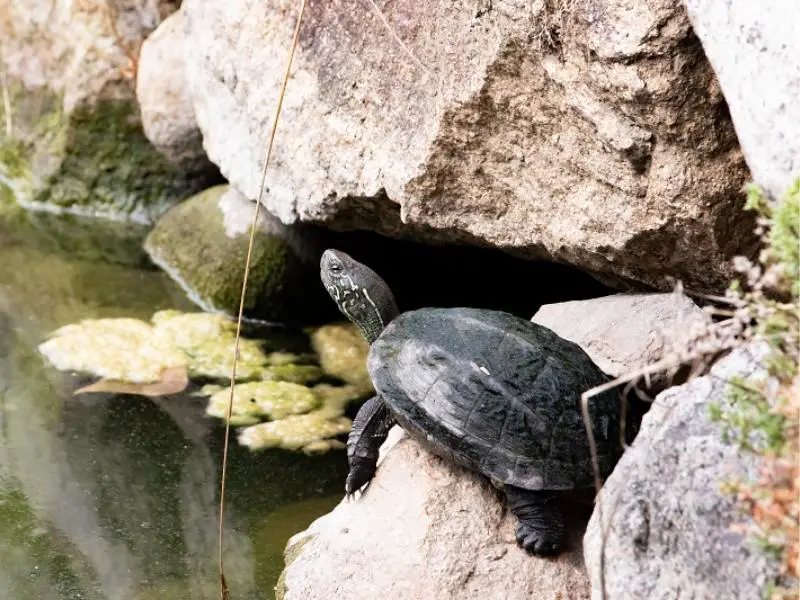
Reeves turtles are hardy turtles that are easy to care for. The turtles’ main care requirements are a high-protein diet, access to filtered swimming water, and clean tank conditions.
Food and Water
Reeves turtles are omnivores and are known for eating almost anything they can fit in their mouths. The bulk of your turtle’s diet should be nutritionally-balanced commercial turtle food, which covers all the turtle’s needs. Ensure the food is supplemented with vitamin D, high in protein, and low in fat, with a 2:1 calcium to phosphorus ratio.
Supplement commercial food with snacks, such as calcium-dusted mealworms, crickets, cockroaches, and leafy greens like lettuce, water hyacinth, and duckweed. These foods add variation to the turtle’s diet and provide additional vitamins and minerals.
Young Reeves turtles have higher protein requirements than adults, so feed juveniles under six months a higher amount of protein-rich commercial turtle food relative to plant-based sources, like leafy greens.
Reeves turtles don’t need a dedicated water bowl because their hydration needs are met by the water portion of the tank.
Handling
Reeves turtles tolerate handling when necessary (such as for medical examinations and to move the turtle to a new tank) but they don’t enjoy being handled on a daily basis.
Overhandling a Reeves turtle will cause the turtle to become agitated and stressed, and the turtle may attempt to escape and become injured. The turtle could also try to scratch or bite you.
Reserve handling a Reeves turtle for essential circumstances. Wash your hands before and after touching the turtle, and be quick and gentle during the handling.
Common Health Issues
Reeves turtles are a hardy species that aren’t prone to many diseases when bred and raised in captivity. Most health issues in these turtles are caused by a poor diet or suboptimal living conditions.
Some of the potential health issues faced by Reeves turtles are:
Metabolic Bone Disease
Metabolic bone disease (MBD) occurs when turtles don’t get enough calcium or aren’t exposed to enough UVB light. Symptoms of MBD include bowed legs, softening of the carapace and plastron, bumps along the tail, and softening of the jaw. Prevent MBD by providing a diet balanced in calcium and phosphorus, proper heat gradients and light/dark cycles, and adequate exposure to UVB rays into the enclosure. Serious cases of MBD require high-intensity UV treatment and calcium supplementation.
Shell Rot
Shell rot is a disease caused by fungal or bacterial infections, and causes pitting, cracking, or flaking of the shell. This disease often occurs following damage or abrasions. Symptoms of shell rot include a slimy layer on the shell plates, a reddish fluid under the shell, an uneven-looking shell, and a foul-smelling odor. Treat shell rot with antiseptic and a healing cream as soon as possible to prevent permanent tissue damage.
Swimming Water
Reeves turtles are an active species that spend many hours per day swimming in water. Monitoring the conditions of the water in your tank is essential to ensure the water is healthy and clean for the turtle to swim in. Test for nitrates and ammonia every one or two weeks and install a powerful water filter to clean debris and waste out of the water.
Every week, change about 20% of the water. This will maintain safe, clean water conditions and reduce the likelihood of your Reeves turtle getting sick.
Breeding
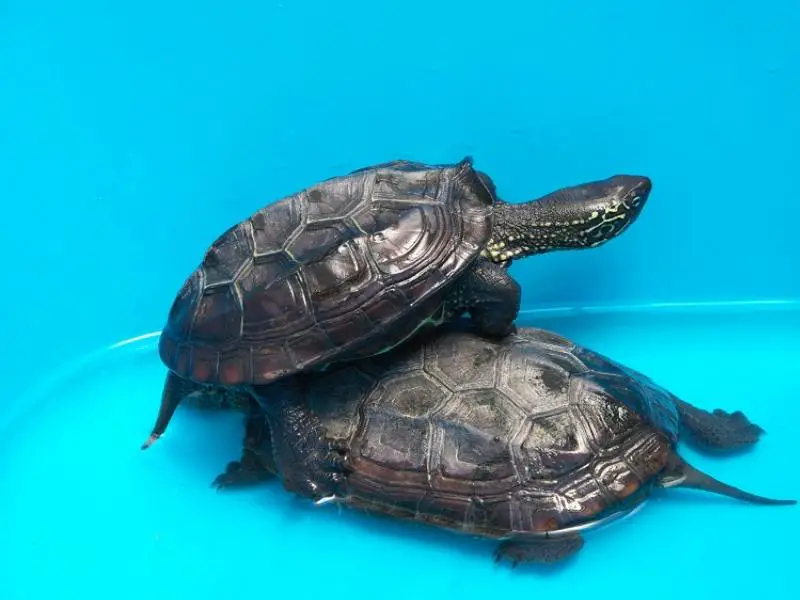
Reeves turtles are easy to breed in captivity and require minimal human intervention. Male Reeves turtles reach sexual maturity around four years old, while females become mature at about seven years old.
To breed a pair of Reeves turtles, follow these steps:
- Place a male and a female Reeves turtle in a 75-gallon tank
- Wait for the turtles to breed naturally. If the turtles are interested, breeding should happen within a couple of months to one year
- Check the female once a week to see if she’s gravid (carrying eggs). Hold the female vertically and carefully check the opening between the bottom of her shell and her hind legs. Feel for small bumps inside the cavity, which indicate that eggs are present
- Set up a nest in the enclosure, large enough for the female to turn around in, made from damp sphagnum moss
- Wait for the female to lose her appetite and start basking frequently. The female will go to the nest when she’s ready to lay her eggs
- Once the female has laid her clutch of two to six eggs, keep the egg enclosure at a temperature of 80–85°F for 60–90 days until the eggs hatch.
- After the eggs hatch, move the hatchlings into a separate 10-gallon tank with about 5 gallons of water. The ambient temperature and water temperature should be about 2 degrees higher than an adult tank
- Feed the hatchlings small pieces of earthworms and commercial turtle pellets once per day, and administer calcium supplements once a week, until the turtles are about one year old and are ready to be moved into their own separate enclosures
Choosing and Buying a Reeves Turtle
A Reeves turtle costs $45–$60, depending on the turtle’s age and sex. Buy a Reeves turtle from a reputable breeder online to ensure the turtle has been raised safely and is healthy. Reeves turtles are widely available due to the ease of breeding the species in captivity.
To choose a healthy Reeves turtle, ensure the turtle has a hard, smooth shell with no defects, sores, cuts, or cracks. Check that the turtle is a healthy weight and doesn’t have swollen eyelids or nasal discharge. Ask to watch the turtle feeding to check that its eating habits are normal.

